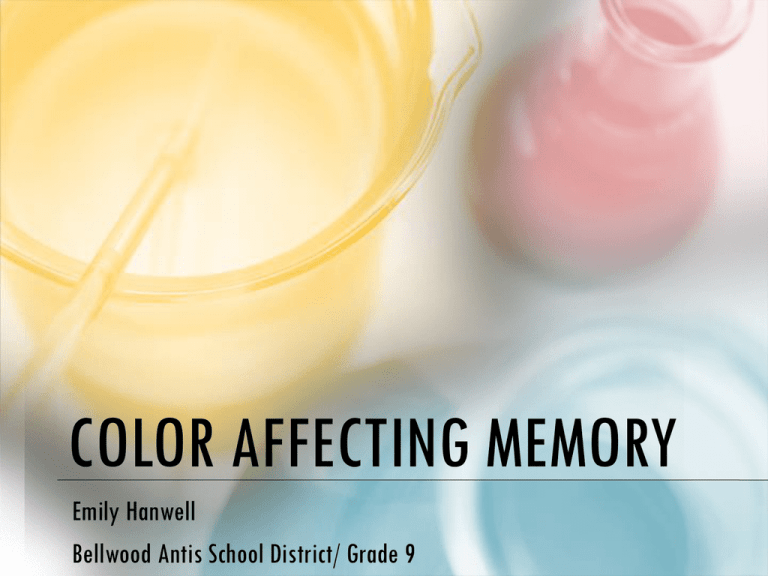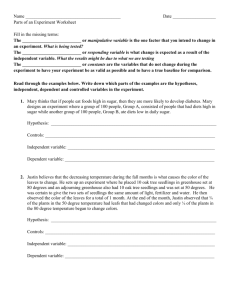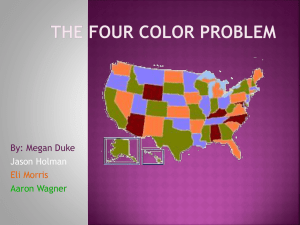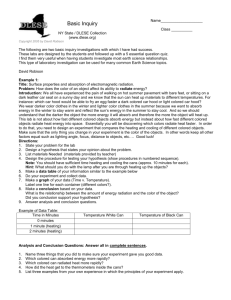Color Affecting Memory good
advertisement

COLOR AFFECTING MEMORY Emily Hanwell Bellwood Antis School District/ Grade 9 I wanted to know what color of paper would improve memory the most. For example, if you are studying for a science test what color would help the studying process go quicker? PROBLEM •Does different color of paper affect memory? RESEARCH • According to Dr. Morton Walker, who wrote the book The Power of Color, stated that different colors have physical affects. –Affects such as lowering heart rate and reducing appetite. FURTHER RESEARCH • The book stated that colors elicit different emotions and reactions. RED VS. BLUE • Red – People pay the most attention to it – Most energetic – Warmest color Have you ever noticed most ads have red in them? RED VS. BLUE • Blue – Lowers body temperature – Slows heart rate – Reduces appetite – Cooler color HYPOTHESIS • My hypothesis for this experiment, is that the color blue will affect memory by improving it the most. EXPERIMENTAL DESIGN • Experimental variables –Colored paper EXPERIMENTAL DESIGN • Experimental Groups –B Group for blue paper –R Group for red paper –Y Group for yellow paper EXPERIMENTAL DESIGN • Control Variables – Eyesight of people used – Time the people have to study – When the people study (During the day) – Number of people used (10) – Age of people used (14-45) – Subjects being isolated and separated from every distraction – Shade of color of paper – Size of paper (Standard size) – Color of font – Size of font – Style of font (Times New Roman) – Number of items on the list (20) – The list of the same items EXPERIMENTAL DESIGN • Control Group –no color, or white paper PROCEDURE This is the procedure I used to test my hypothesis. Step 1. After gathering all materials and 10 subjects, give the isolated person a list of 20 items in black ink on each colored paper (red, yellow, blue, and white) STUDYING PROCEDURE Step 2. Allow subject to study the list by following this procedure: 1. Subjects will be placed alone in a room with limited distractions. 2. Study for 60 seconds. 3. Give the subject one color of paper at a time. 4. Once the subject’s time is up stop them from studying and then instruct them to verbally repeat the items back in order. PROCEDURE This is the procedure I used to test my hypothesis. Step 1. After gathering all materials and 10 subjects, give the isolated person a list of 20 items in black ink on each colored paper (red, yellow, blue, and white) PROCEDURE CONTINUED Step 3. Instruct the individual to verbally repeat the list of items in order that was on the paper. Step 4. Record how many they get right. When the subject makes a mistake, end the count. PROCEDURE –ADDITIONAL TRIALS Step 5. Repeat with another subject (same color of paper) until 10 have been tested. Step 6. Repeat using a different colored paper and rearranged list. Step 7. Repeat using white paper this is my control group. DATA TABLE C o l o r o f p a p e r 1 Subjects 2 3 4 5 6 7 8 9 10 4 3 2 3 12 4 4 7 4 6 Yellow 6 1 6 1 3 7 1 8 7 2 Blue 3 5 2 2 3 4 8 3 7 10 Red 3 8 6 3 6 8 7 4 8 9 White *Numbers mean the number of correct answers each subject got per color of paper. N u m b e r o f c o rr e ct a n s w e r s CORRECT ANSWER BAR GRAPH 70 60 50 Blue Red Yellow White 40 30 20 10 0 Colors STANDARD DEVIATION Chart Title A x i s T i t l e 20 18 16 14 12 10 8 6 4 2 0 White Yellow Blue Axis Title Red CONCLUSION • My data does not support my hypothesis. Therefore, I reject my hypothesis that blue colored paper would affect memory the most by improving it. POSSIBLE IMPROVEMENTS • Have more people perform the experiment. • Use all of the colors of the rainbow. • Use people of the same age.



![Hypothesis_Assignment JAKE 4-15-10[1]](http://s2.studylib.net/store/data/009882853_1-b17c575676aa8cb47185490614ca3e03-300x300.png)







